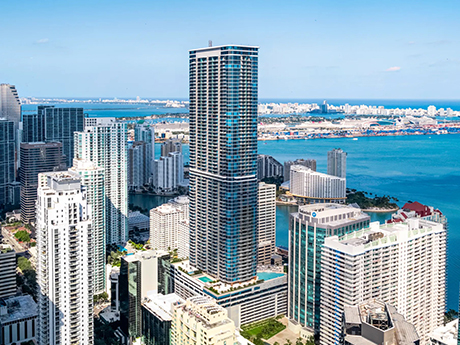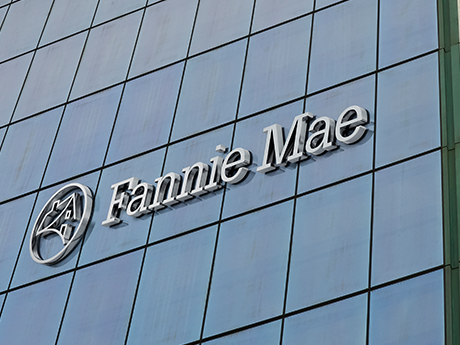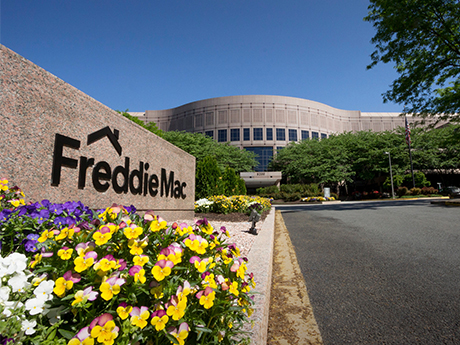By John Nelson
Lending activity in the multifamily divisions of Fannie Mae and Freddie Mac is in the midst of a prolonged slump.
The 2023 multifamily loan volumes for the government-sponsored enterprises (GSEs) were down significantly year-over-year, with Fannie Mae at $52 billion last year (compared to $69 billion in 2022) and Freddie Mac at $48 billion (compared to $73.8 billion in 2022).
And it doesn’t appear that deal volume will return to the frothy levels achieved in 2022 this year. Fannie Mae executed $10.1 billion in loans during the first quarter of 2024, which is almost identical to its first-quarter 2023 production. Freddie Mac generated $9 billion in multifamily loans in the first quarter — up significantly from $6 billion in first-quarter 2023 — but down nearly 45 percent from fourth-quarter 2023.
While the GSEs freely acknowledge the slowdown in business, they are more than holding their own when it comes to serving borrowers.

The Mortgage Bankers Association (MBA) reports that multifamily loan originations totaled $264 billion in 2023, with the agencies accounting for 38 percent of all multifamily originations. By comparison, the share of overall multifamily originations was closer to 29 percent for Fannie Mae and Freddie Mac in 2022.
“It’s actually more robust than a typical year when you think about it,” explains Jeff Erxleben, president of Northmarq’s debt and equity platform. “There’s a more finite pool of lenders overall, particularly on the banking side. A larger percentage of deals is going to Freddie and Fannie now because they’re the best game in town.”
Robert Vaughn III, agency relationship manager for Colliers Mortgage, says that one point to keep in mind for the current state of lending, even outside of Fannie Mae and Freddie Mac, is that borrowers are more fickle than in years past. This mindset is due to external circumstances beyond their control, namely higher interest rates.
“We’re seeing a lot of requotes — borrowers are waiting for rates to drop or they’re trying to renegotiate a purchase price, or they come back to the table and ask for another year of interest-only payments,” says Vaughn. “All those items have to be requoted, so agencies are having to quote deals multiple times, which slows down the process.”
The agencies are still executing deals, despite the hurdles. In 2023, the Freddie Mac Targeted Affordable Housing Team (TAH), along with its network of Optigo lenders that originate loans on behalf of the agency, had its second-bigged year on record, according to a spokesperson at Freddie Mac Multifamily.
“In a year where volume was down an estimated 45 percent in the overall multifamily market, the Freddie Mac TAH team exceeded our most ambitious affordable housing goals ever,” says a spokesperson at Freddie Mac Multifamily. “In the current market environment, Freddie Mac is particularly focused on our role in providing liquidity to the market and remaining active and open for business, even when other market participants pull back.”
The quality of Freddie Mac multifamily loans is also being fine-tuned. In mid-April, the agency announced a series of policy and processing enhancements for its multifamily loan products, including more thorough property inspection requirements and additional due diligence during the underwriting process. These measures are intended to deter fraudulent activity among renters, which is a growing concern for the industry.
“These enhancements are just the latest step in our effort to manage risk and improve our execution, alongside our Optigo lenders. As part of our focus on risk management, we continually work to enhance our processes to better detect and deter fraud and misrepresentation,” says the Freddie Mac spokesperson.
Acquisitions making a return?
The volume of acquisition loans, a pillar of multifamily originations, has unsurprisingly fallen off due to the recent slowdown in investment sales activity. According to MSCI Real Capital Analytics, U.S. multifamily sales volume in 2023 totaled $119 billion, a 61 percent plunge from the prior year. In 2021 and 2022, multifamily sales volume averaged $332 billion per year.
Sources concur that in order for sales volume to accelerate, the bid-ask spread between buyers and sellers needs to narrow. Ann Atkinson, managing director of Regions Real Estate Capital Markets, says that her firm has started to see investment sales creep up, though buyers remain selective.
“We are seeing more acquisition activity, albeit still slow,” says Atkinson. “While cap rates have increased over the last six to 12 months, there are still gaps in bid-ask in certain markets. We anticipate acquisition activity to pick up again when interest rate cuts begin.”
U.S. multifamily cap rates rose by 33 basis points to an average of 5.4 percent from fourth-quarter 2023 to first-quarter 2024, according to CBRE. This acceleration is notable given that cap rates rose 44 basis points for the entire 2023 calendar year.
The rising of cap rates hasn’t yet translated to more traction in sales. In the first quarter of 2024, multifamily investment sales totaled $20.6 billion, according to MSCI Real Capital Analytics. It was the lowest quarterly investment sales volume since the second quarter of 2020 — during the onset of the COVID-19 pandemic — and is also down 25 percent below first-quarter 2023 sales volume.

RealPage reports that quarterly multifamily sales volume averaged $42.2 billion in the five years leading up to the pandemic.
Despite underwhelming transaction volume, Vaughn is encouraged that precursors to acquisition activity are starting to gain momentum, which he says should lead to increased investment sales activity in the near future.
“We’re starting to see some green shoots — deals are starting to come to market or borrowers are getting brokers’ opinions of value (BOVs),” says Vaughn. “Sellers are testing the waters.”
The Freddie Mac Multifamily spokesperson adds that acquisition financing has been increasing as a percentage of overall volume throughout the year thus far.
‘Higher for longer’
The federal funds target rate is not only one of the Federal Reserve’s key tools for guiding U.S. monetary policy, but it also influences credit card and mortgage rates. The fed funds rate currently ranges from 5.25 to 5.5 percent — a level unchanged since July 2023 — up from near zero percent in March 2022.
The Federal Reserve telegraphed as many as three cuts in the fed funds rate in 2024, but hotter-than-expected inflation data has caused the Fed to hit the pause button on rate cuts. The Consumer Price Index (CPI) increased 3.4 percent in April on an annualized basis, down from 9.1 percent in June 2022. The Fed would like to see the inflation rate closer to 2 percent before it begins cutting interest rates.
Meanwhile, the yield on the 10-year U.S. Treasury note, a benchmark used to set fixed interest rates on long-term acquisition and refinancing loans in commercial real estate, stood at 4.62 percent on May 29. That’s up from approximately 2.4 percent in March 2022 when the Fed first began a series of hikes in the fed funds rate. The 10-year yield briefly surpassed 5 percent in October 2023 before receding.
Many commercial real estate lenders point out that movement in the fed funds rate has a more direct impact on short-term U.S. Treasury notes than it does on longer term bonds. The trajectory of the 10-year yield, they say, is impacted by other factors such as investor confidence, strength of the national economy and inflation.
Jeff Patton, national director of agency relationships at BWE, says that the certainty that many in the industry felt at the beginning of the year is dissipating as borrowers accept that they’re now in a “higher for longer” interest rate environment.
“The industry’s expectations regarding interest rates have shifted dramatically since the start of 2024. When the 10-year Treasury yield was hovering just below 4 percent, with an expectation of up to six Fed rate cuts right around the corner, many clients were hoping for a return to interest rates and cap rates from the first half of 2022,” says Patton.
“Now it feels like we are all excited if the 10-year Treasury yield holds flat at 4.5 percent for more than a few days,” he continues. “This points to the danger of pricing in lower interest rate expectations and delaying financing decisions.”
T.J. Edwards, chief production officer at Walker & Dunlop, says that for Fannie Mae and Freddie Mac borrowers, the time is now if they want to get a deal done.
“We’ve been telling our clients there are too many foreign and domestic economic unknowns and political factors to confidently predict future market conditions,” says Edwards. “If a deal works for them at today’s rates, then go ahead and transact.”
“We are advising clients who can make a deal work at these rates to seriously consider pulling the trigger,” adds Patton.
Vaughn says that skeptics may believe it is self-serving for mortgage brokers to advise clients to transact. But financial intermediaries concur that it comes down to mitigating risk and also having a more holistic approach in regard to multifamily borrowers’ role in the U.S. economy.
“If your deal works, lock it in and take that interest rate risk off the table. There are lots of other risks that you have in real estate. That’s one that you can control,” says Vaughn. “If you’re waiting for rates to drop significantly, you’re really waiting for the Treasury [yield] to drop significantly, which usually occurs because something bad happened in the economy. So if you’re waiting for fixed-rate debt to go down a lot, you’re really hoping for something bad in the economy, which is not a great strategy.”
In response to higher interest rates, multifamily borrowers are unsurprisingly choosing fixed interest rates for their loans. Erxleben says that Northmarq’s book of agency loans has shifted to more fixed- versus floating-rate debt over the past three years.
“Northmarq’s quoted business is closer to 80/20 fixed versus floating as opposed to being pretty balanced at 50/50 historically,” says Erxleben. “Floating-rate financing has curtailed quite a bit.”
Sources all agree that the most popular underwriting today for agency loans is five-year, fixed-rate debt. Borrowers are migrating in the direction of shorter terms in order to maximize optionality if and when rate cuts occur in the future. Additionally, Erxleben says that Fannie Mae and Freddie Mac have made their five-year, fixed-rate loan products more attractive for borrowers seeking flexibility in terms of more lenient prepayment penalties.
“With what has been tweaked on five-year financing from both agencies, it’s really a more competitive product now,” says Erxleben. “Now you can have prepay flexibility, which mirrors the flexibility that most clients were looking for on a floating-rate deal.”
“The agencies adjust underwriting standards as market conditions change. We saw this during previous market cycles, including during the COVID-19 pandemic,” says Atkinson of Regions Real Estate Capital Markets. “Fannie Mae and Freddie Mac remain a consistent source of liquidity in all market conditions.”
Edwards adds that the agencies still provide longer amortization schedules (typically 35 years) than their competitors, which is an attractive feature for borrowers looking for certainty as well as flexibility.
“In the first quarter of 2024, a majority of deals have been five-year, fixed-rate terms, reflecting the ability of Freddie Mac to meet the needs of the market, even in volatile or challenging times,” the spokesperson at Freddie Mac confirms.
Vaughn of Colliers Mortgage says that five-year loans are replacing the standard 10-year debt commonplace in previous years. The downside of shorter terms is that it increases refinance risk for borrowers and, unlike in past years, the interest rates aren’t materially more attractive.
“During a 10-year period, you’re probably going to have a couple of down years. But if you look back historically, and you pick almost any 10-year period, you’re going to have seven or eight good years,” says Vaughn. “You can weather one or two (or three) bad years during a 10-year loan. If you get a five-year loan, and you have two bad years, that can make your refinance a lot more difficult.”
Patton says that many borrowers of both short- and long-term agency loan products are choosing to buy down their interest rate. In this scenario, borrowers pay a non-refundable fee to buy down the interest rate for the life of the loan, most of which are in the neighborhood of 100 to 200 basis points.
The Freddie Mac spokesperson confirms that the buydown loan product is one of the more popular choices for its multifamily borrowers thus far this year.


